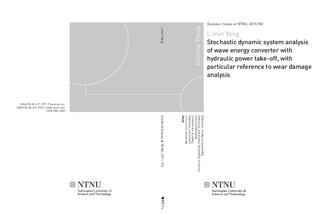| dc.description.abstract | The study of the renewable energy has drawn increasing attention in the recent years. Wave energy with its relatively high power density is a major resource that has remained untapped until recently. Different types of wave energy converters have been proposed for extracting the energy from the waves. In this thesis, a heaving semi-submerged buoy, moving relative to a fixed reference to drive hydraulic power take-off, was studied.
To meet stringent in-service and operational requirements, the components of a wave energy converter (WEC) need to have high levels of reliability and availability. Hence, it is necessary to develop mathematical models that enable a numerical solution with sufficient accuracy and computational efficiency, and apply these models to assess the energy capture and the safety and availability of the system based on relevant reliability theory.
The studied wave energy converter system consists of several subsystems, i.e., a floating buoy, a hydraulic pump, check valves, transmission lines, accumulators, a hydraulic motor and an electric generator, where energy is converted between several energy domains, and each belongs to a different engineering discipline. An integrated dynamic model in the state space form was established for this system of components. The dynamic characteristic of the considered wave energy converter system was studied, with particular reference to high frequency oscillations (HFO) of the buoy and the transient pressures in the pipelines.
High frequency oscillations (HFOs), as defined in this thesis, refer to the motions of the buoy that oscillates at frequencies much higher than those of the incident waves. HFOs were observed in the time interval when no fluid was pumped or sucked between the hydraulic pump and accumulators. This type of motion is mainly caused by the fluid compressibility of the hydraulic pump. The analytical solutions of the oscillating frequencies, which depend on the hydraulic cylinder parameters, were derived in this study. The results show that the HFOs contribute significantly to the wear damage of the hydraulic pump, especially to the wear loss of cylinder bore. Because of the notable effect on the wear estimation, a dynamic wave energy converter model that can describe the HFOs is developed in the thesis.
The transient pressure in the pipeline, which accompanies any sudden change in the rate of fluid flow, was another detrimental load studied in the thesis. The magnitudes of the transient pressures can be many times larger than the normal operating pressure and may cause fatigue and catastrophic failures. This fact raises the question of how to predict and mitigate the pressure pulsations. In this study, pipeline dynamics were taken into account in the form of modal representations. In addition, to predict the opening and closing times of the valve operation, which directly affect the magnitude of the transient pressures, a dynamic model of the check valves is also introduced. By combining the subsystem models of pipelines and check valves with the models of other subsystems employed in the wave energy converter system, the transient pressures were calculated numerically. Moreover, the effect of the pipelines connected between the hydraulic pump and check valves on the electric power production is also investigated in this research work.
The hydraulic pump, which converts the kinetic energy of the buoy into hydraulic energy of the working fluid, plays an important role in the proposed wave energy converter system. Wearing of the piston rings and cylinder bore significantly contribute to hydraulic pump failure. This research focuses on wear damage of the piston rings and cylinder bore under random sea state conditions. An abrasive wear model that considers the effect of the sealed pressure, lubrication condition, surface roughness, material properties, relative velocity and the cutting efficiency was developed. Based on the wear model and hypothesis of linear cumulative loss, a W - Tf approach (wear work rate versus time duration for wear damage growth till failure) was provided to estimate the piston ring wear resistance. By taking into account the occurrence probability of each sea state, a long-term wear damage estimation model was finally derived and given in the thesis. Because it is very time consuming to calculate the wear damage by considering all of the sea states, focus should be on the sea states that represent the most significant contribution to wear. In this thesis, the relative contribution of wear for the piston ring and cylinder bore from different sea states was calculated. The primary sea states contributing to wear can be found easily from the obtained figures.
The last topic of this research work is to construct modal bond graphs for the transmission lines. To model a pipeline with fluid pressures and flow rates at its two ends (i.e., the upstream side and downstream side) as input-output variables, four possible boundary conditions—pressure inputs at both ends, flow rate inputs at both ends and the two cases of mixed inputs—should be taken into account. The pipeline dynamics can be approximately modelled with modal models, which can be represented in the bond graph forms. To derive the modal models, two methods, separation of variables (SOV) and rational transfer function (RTF*) may be used. In this thesis, modal bond graph representations were reviewed and new bond graph models were proposed for combinations of the solution methods and input-output configurations not yet presented in the literature, which include a bond graph for the two mixed input cases developed using the SOV technique and bond graphs for the other two cases (i.e., pressure inputs or flow rate inputs) constructed based on RTF solutions. It is found that the modal models derived by SOV and RTF have the same accuracy when the same number of modes is employed. With the developed bond graph models, the pipelines which are coupled with any other dynamic elements and systems can be modelled and analysed straightforwardly. | nb_NO |

